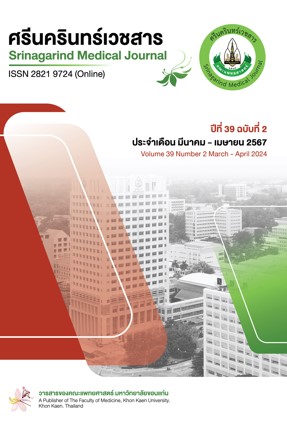Effects of Modified Foot Abduction Brace in Maintaining the Foot Position after Ponseti Treatment Method in Congenital Clubfoot
Keywords:
congenital clubfoot, Ponseti method, foot abduction braceAbstract
Objective: Modify the Foot Abduction Brace (FAB) and measure the slippage of the FAB to obtain a suitable FAB for maintaining the position of the patient's foot and to study of parents' satisfaction with modified FAB.
Methods: An action research was conducted in 2 stage stage 1 Modify the FAB according to interdisciplinary consensus. Stage 2 twenty-nine patients with congenital clubfoot who have been treated with the Ponseti method will receive FAB from the outpatient rehabilitation department at Srinagarind Hospital to maintain foot shape for 7 days. Parents record FAB slippage, satisfaction, and problems encountered in using the modified FAB in the diary and telephone interviews.
Results: Of the 29 congenital clubfoot patients, 21 were male (72.4%), with a mean age of 10.6 ± 7.9 months. The mean age at initiation of FAB usage was 21.2 ± 2.7 weeks. Fourteen patients (48.3%) started using the FAB for the first time. The study found that 69.0% - 79.3% of patients had no FAB slippage during usage. The average number of FAB slippages were 1.2 ± 2.4 times/day (median = 0, interquartile range 0-1). Parental satisfaction was reported at 4.7 ± 0.6 points, with the highest satisfaction regarding fit and durability (4.6 ± 0.6 and 4.6 ± 0.8, respectively).
Conclusion: By modifying both the shoe and strapping of the FAB found minimal instances of FAB slippage. Moreover, the parents expressed high satisfaction in using the FAB, which was also cost-effective and covered by government reimbursement.
References
Ganesan B, Luximon A, Al-Jumaily A, Balasankar SK, Naik GR. Ponseti method in the management of clubfoot under 2 years of age: a systematic review. PLoS One 2017;12(6):e0178299. doi: 10.1371/journal.pone.0178299
WHO | Congenital anomalies [Internet]. WHO. World Health Organization; [cited Dec 5, 2020]. Available from: http://www.who.int/surgery/ challenges/esc_congenital_nomalies/en/
Smythe T, Kuper H, Macleod D, Foster A, Lavy C. Birth prevalence of congenital talipes equinovarus in low and middle income countries: a systematic review and meta-analysis. Trop Med Int Health 2017;22(3):269-85. doi: 10.1111/tmi.12833
Bina S, Pacey V, Barnes EH, Burns J, Gray K. Interventions for congenital talipes equinovarus (clubfoot). Cochrane Database Syst Rev 2020;5(5):CD008602. doi: 10.1002/14651858.CD008602.pub4
Colburn M, Williams M. Evaluation of the treatment of idiopathic clubfoot by using the Ponseti method. J Foot Ankle Surg 2003;42(5):259–67. doi: 10.1016/s1067-2516(03)00312-0
Ponseti IV, Smoley EN. The classic: congenital club foot: the results of treatment. Clin Orthop Relat Res 2009;467(5):1133–45. doi: 10.1007/s11999- 009-0720-2
Sayıt E, Uruç V. The treatment of clubfoot with the Ponseti method: a systematic review. J Clin Anal Med 2014;5(suppl 3):400-4. doi: 0.4328/ JCAM.2791
Ponseti IV. Clubfoot management. J Pediatr Orthop 2000;20(6):699–700. doi: 10.1097/00004694-2000 11000-00001
Ponseti IV. Treatment of congenital club foot. J Bone Joint Surg Am 1992;74(3):448–54. PMID: 1548277
Zhao D, Liu J, Zhao L, Wu Z. Relapse of clubfoot after treatment with the Ponseti method and the function of the foot abduction orthosis. Clin Orthop Surg 2014;6(3):245–52. doi: 10.4055/ cios.2014.6.3.245
Agarwal A, Shaharyar A, Kumar A, Bhat MS, Mishra M. Steenbeek brace: patterns of wear. Foot Ankle Spec 2016;9(1):13–6. doi: 10.1177/19386400 15592838
Zionts LE, Dietz FR. Bracing following correction of idiopathic clubfoot using the Ponseti method. J Am Acad Orthop Surg 2010;18(8):486–93. doi: 10.5435/00124635-201008000-00005
Radler C. The Ponseti method for the treatment of congenital club foot: review of the current literature and treatment recommendations. Int Orthop 2013;37(9):1747–53. doi: 10.1007/s00264- 013-2031-1
Memon I, Bhatti A, Ali P, Mahmood K, M. Saeed Minhas. Difficulties in maintenance of clubfoot abduction brace and solutions - maintenance of clubfoot abduction brace, locks and keys. J Pak Med Assoc 2014;64(12):70-5. PMID: 25989785
Haft GF, Walker CG, Crawford HA. Early clubfoot recurrence after use of the Ponseti method in a New Zealand population. J Bone Joint Surg Am 2007;89(3):487–93. doi: 10.2106/JBJS.F.00169
Avilucea FR, Szalay EA, Bosch PP, Sweet KR, Schwend RM. Effect of cultural factors on outcome of Ponseti treatment of clubfeet in rural America. J Bone Joint Surg Am 2009;91(3):530–40. doi: 10.2106/JBJS.H.00580
Morcuende JA, Dolan LA, Dietz FR, Ponseti IV. Radical reduction in the rate of extensive corrective surgery for clubfoot using the Ponseti method. Pediatrics 2004;113(2):376–80. doi: 10.1542/peds.113.2.376
Hemo Y, Segev E, Yavor A, Ovadia D, Wientroub S, Hayek S. The influence of brace type on the success rate of the Ponseti treatment protocol for idiopathic clubfoot. J Child Orthop 2011;5(2):115–9. doi: 10.1007/s11832-010-0321-3
Memon AU, Jat AHM, Ahmed T, Butt SA, Memon FA, Kumar S, et al. Club foot: nature and gender distribution. Pakistan Journal of Medical and Health Sciences 2021;15(4):806–8.
Esbjörnsson AC, Johansson A, Andriesse H, Wallander H. Epidemiology of clubfoot in Sweden from 2016 to 2019: a national register study. PLoS ONE 2021;16(12):e0260336. doi: 10.1371/journal. pone.0260336
Sahoo PK, Vijay M, Das SP, Sahu MM, Sanyal A. Effectiveness of dynamic over static foot abduction brace and evaluation of impact of parental socioeducational status in the maintenance phase of clubfoot correction. Journal of Musculoskeletal Surgery and Research 2021;5(2):109-15. doi: 10.4103/jmsr.jmsr_136_20
Chen RC, Gordon JE, Luhmann SJ, Schoenecker PL, Dobbs MB. A new dynamic foot abduction orthosis for clubfoot treatment. J Pediatr Orthop 2007;27(5):522–8. doi: 0.1097/bpo.0b013e 318070cc19
Chong DY, Finberg NS, Conklin MJ, Doyle JS, Khoury JG, Gilbert SR. Prospective evaluation of the use of Mitchell shoes and dynamic abduction brace for idiopathic clubfeet. J Pediatr Orthop B 2014;23(6):501–4. doi: 10.1097/BPB.000000 0000000090
Downloads
Published
How to Cite
Issue
Section
License
Copyright (c) 2024 Srinagarind Medical Journal

This work is licensed under a Creative Commons Attribution-NonCommercial-NoDerivatives 4.0 International License.




